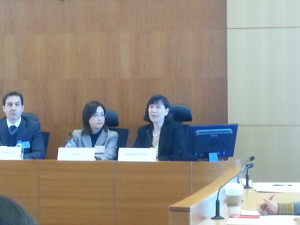Dr. Yahong Li (photo: middle), Associate Professor, Faculty of Law, University of Hong Kong, demonstrated how innovation has been prioritised in the People’s Republic of China during the years.
– National Medium and Long Term Plan for Science and Technology Development 2006-2020, which declared sanguinely that China will become an innovation-based economy by 2020!
– The State Council “383” reform plan (2013), “Promoting innovation is one of the eight key reform priorities.”
– National Patent Development Strategies (2011-2020), “China will rank among the top two in the world in terms of the annual number of patents for inventions.” The total number of patent applications by 2015: 2 million. “The patent system has not become fully integrated with development of socialist market economy, and its role has not been brought into full play in guiding industrial restructuring and upgrading and promoting China’s innovation capacity.”
– Outlines of National IP Strategies (2008): “improving the capacity to create, utilize, protect and administer IPRs, and making China an innovative country.”
Professor Li’s conclusion that quantity of patents does not necessarily translate into innovation hits the nail on the head. She argued rightly that “national innovation and competitiveness eventually depend on true innovative culture and comprehensive innovation framework including the effective
mechanisms for tech transfer and commercialization.”
Read here Professor Li’s slides: http://www.lawtech.hk/wp-content/uploads/2015/01/HKU-IPD-IP-forum-2015-Yahong.pdf
See more of the Worldwide Patent Law Reform and Hong Kong’s Response HKU Workshop here: http://www.ipdragon.org/2015/01/17/worldwide-patent-law-reform-and-hong-kongs-response-hku-workshop/.

